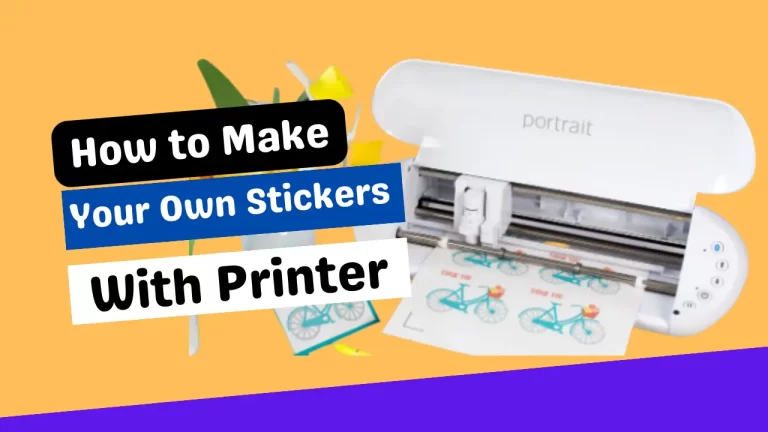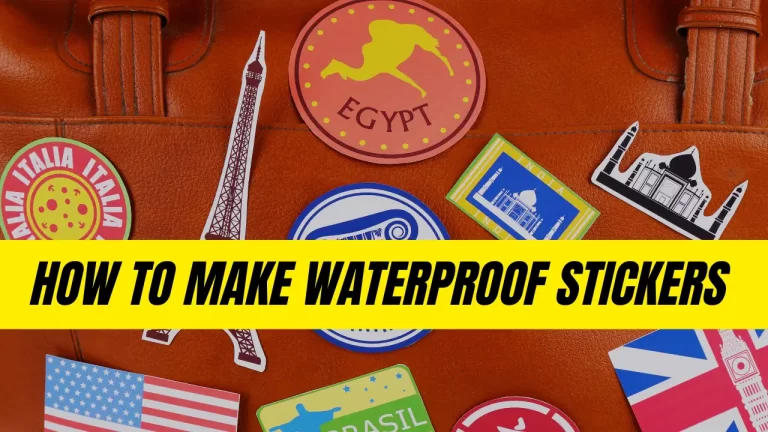DTG vs DTF ~Learn About Attributes TO Make A Clear Difference 2023

Direct-to-garment and direct-to-film print techniques are currently all the rage in the digital printing universe. DTG has been a favorite among customization business owners for quite some time now. It is because of its ability to produce vibrant colors and durable designs at an elevated pace. But recently, DTF has created a buzz in the garment printing industry. Apparel decoration businesses are smitten by how easy it is to learn and how profit-yielding it can be for their business. The names DTG and DTG sound similar, which is why there is a lot of confusion among the users about which one is better. Though they have a few similarities, there also exist a few differences between the two techniques.
You may have been looking forward to expand your apparel business but unsure whether to opt for DTG or DTF printing solution. Reaching a definitive conclusion is difficult, but we are here to help. In this article, we will compare the two fastest-growing printing methods. You will learn the pros and cons of each process and will be able to choose the suitable printing method for your unique business needs. Let’s get into it!
DTG VS DTF Comparison
| DTF | DTG | |
| DTG VS DTF Startup Cost | The initial investment for DTF printing is considerably lower than for DTG printing. You can get an affordable DTF printer for as low as a thousand dollars and a high-end printer for around $5000. Also, the supplies for DTF printing, such as inks, transfer films, adhesive powder, etc., are reasonably priced. You need to purchase a heat press to print designs via DTF printing. | DTG is the most expensive digital printing method in terms of the initial cost. The price of DTG printers ranges from $12,000 to $20,000. It also requires purchasing a pre-treatment machine, a pre-treatment solution, a heat press, and RIP software. Even if you invest in cheap printers and budget-friendly consumables, you will still require a minimum of $12,000. |
| DTG VS DTF Per Print Cost | You require more consumables for DTF printing than for DTG, where you print directly on the garment. You need to purchase transfer films, DTF inks, and adhesive powder. But, the inks for DTF cost far less than DTG inks. Also, DTF printers consume much less ink than DTG printers. You can also reduce the expenditure by printing multiple designs on film paper; it is available in different sizes. | The cost of consumables is a significant factor after startup investment. DTG inks are expensive, especially the white ones. However, you can buy relatively affordable third-party inks. You will also need to spend on a pre-treatment solution. Even the most affordable liquid for pre-treatment costs about a hundred dollars. |
| DTF VS DTG Print Speed & Efficiency | With DTG printing, you need to print the design on a specialized film paper, coat it with adhesive powder, and then adhere it to the fabric with a heat press. The process is long, labor-intensive, and less efficient than DTG printing. But, the upside of DTF printing is that you do not need to pre-treat the garment. Also, you can save time by printing your hot favorite designs on transfer film and storing them for future orders. | DTG printers are fast, and since you are directly printing on fabric, the process is quicker and hassle-free. You have to pre-treat the garment, print the design over it, and then cure it. Through DTG printing, you can create up to 300 custom designs in an hour. Pre-treating the fabric requires a few extra minutes, and you cannot skip pre-treatment. It is essential for quality prints. |
| DTF VS DTG Print Quality | DTG printing is favorable for its vibrant, premium-quality prints on fabric. The designs have a smooth finish as the inks sink into the fabric. The clothing will be comfortable and breathable. You can print as complex images as you want with DTG printing; the results will be excellent. It is perfect for photorealistic images and intricate designs. You can also print designs with effects like 3D, flames, shadows, etc. DTF printing lacks this ability. | The design transfers done through DTF printing have a rough feel. The adhesive powder has a thin layer over the top that can be uncomfortable for the wearer. The plasticy effect is more prominent on cotton but hardly noticeable on synthetic fabrics like polyester. However, the color accuracy and vibrancy of the designs are good but not as good as DTG-printed designs. |
| DTF VS DTG Versatility | When it comes to media handling capacity, DTG printing has some limitations. You cannot print quality designs on silk or polyester fabrics. DTG printers work best with linen, cotton, combed cotton, etc. | DTF printing outweighs DTG printing as there is no limit to what you can print your designs on; you can use nylon, polyester, canvas, leather, denim, spandex, etc. Since you are not feeding the fabric directly into the printer, DTF printing allows you to scale up your customization business. It enables you to print on hard surfaces like ceramic plates, mugs, caps, shoes, etc. With DTF printing, you can print smaller patterns and designs for specific parts like collars, pockets, sleeves, etc.; you cannot achieve this with DTG printing. |
| DTF VS DTG Durability | DTG-printed designs are more durable than DTF-printed designs. With appropriate care and washing, they survive up to sixty washes. The pre-treatment process is one of the core reasons why custom images printed through DTG printing last longer than DTF printing. | DTF printers are suitable for short-run designs. The images you print through DTF printing last up to 40 washes. |
| DTF VS DTG Maintenance | DTG printers require regular cleaning and maintenance as they utilize a significant amount of white ink. White ink can cause several clogging and maintenance issues. | DTF printers are easy to maintain as they use much less white ink than DTG printers. A regular print head cleaning cycle is necessary to keep the printer fully functional. |
DTG
Direct-to-garment (DTG) printing is the process of digitally printing a garment in the same way that you would print a document on your desktop printer. You must first digitize a design into the device, after which software makes it into a set of commands to print the respective garment.
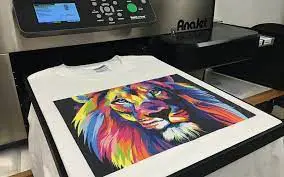
The garment must be pretreated with a special solution before printing. This solution keeps the inks from being assimilated into the garments while highlighting the ink colors. After pre-treatment, the garment have been dried by using a heat press.
After this, the shirt is then placed on the printer’s base plate and made sure it’s correctly set for printing. The printer will create the design by applying ink to the garment’s surface with strictly managed print heads. After printing, heat press it again, and your garment is done!
The ability of DTG printing to print complex designs with multiple colors at relatively fast color speeds is its main selling point. It’s particularly fit to reach out to small-time customers looking for one-of-a-kind custom prints on fewer than 30 shirts per order, which screen printing cannot do effectively.
To make your working unit more affordable, receiving more orders is the only way. This works against it when it comes to small orders, as it becomes less expensive to print small quantities with the time, labor, and preparation required to print a batch.
DTF
DTF printing, on the other hand, uses a special transfer film to print designs. The illustrations will be printed on the back side of the film before being coated with a hot melt powder. The powder acts as an adhesive, assisting the inks to bond to the garment when the design is applied to the chosen garment with a heat press.
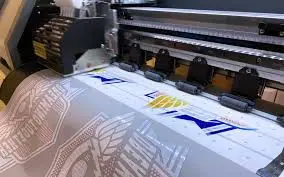
DTG and DTF printing both use digital inkjet technology to print designs on substrates. The difference is that DTG prints directly onto the substrate, whereas DTF uses transfer films as a medium to convey the design to the substrate.
The primary advantage of DTF printing is its low cost. Components such as printer inks, transfer films, and hot melt powder are reasonably priced, allowing you to keep costs low while maximizing revenue from your prints. You can easily print multiple designs on a single sheet or length of the film as you’re printing on sheets or rolls of film.
DTF is also a highly adaptable printing method. In addition to allowing, you to heat press your prints onto garments, it also works on a variety of other substrates. Polyesters, glass, ceramics, and even metal. Additionally, you can keep extra prints for later use or sell them to people who want to do it themselves!
Learn below pros and cons of DTG and DTF
DTG VS DTF Pros and Cons
There is not a single printing technology that you can claim is the best solution for all printing needs. Every print technique has its own pros and cons. Let us look at the benefits and drawbacks of DTG and DTF print technologies.
DTG Pros and Cons
Pros
- Eco-friendly
- Durable
- Excellent print quality
- Fast and efficient
- Suitable for bulk printing
- Smooth design feel
- Easy to learn
- Profitable
Cons
- High startup investment
- Requires pre-treatment
- You can only print on flat surfaces.
- Consumes more ink
DTF Pros and Cons
Pros
- Low startup cost
- Versatile media handling
- Low cost-per-print
- No pre-treatment required
- Uses less ink
- Can print small designs for specific clothing parts
- You can print and save designs on films for later
Cons
- Requires more effort
- The designs are less durable and have a rough feel.
- Not eco-friendly
- Lengthy process
COMPARING DTF VS DTG COST
Startup Cost
How to take a kick start by investing little with lasting benefits. DTG is unquestionably the more expensive of the two options. A regular DTG printer can cost between $13,000 and $25,000 – and that’s only for the printer! When you include a pre-treatment machine, pre-treatment solution, a heat press, and RIP software, your bill will shoot through the roof. Even if you purchase a relatively affordable entry-level printer, the total budget for basic items and equipment can reach $12,000 or more!
When it comes to DTF, printers, inks, transfer films, and a heat press are the only requirements. With a limited budget, you can easily obtain a cost-efficient converted desktop printer, a heat press, and other items. Most interestingly, you will not require a pre-treatment machine or solution, further bringing down your costs.
A refurbished digital printer that is used for document printing has been standardized to print on DTF transfer films. DTG- converted printers were once popular as a low-cost way to get started with DTG printing.
Prices for a converted printer range from $600 to $2,000 from multiple online distributors. Your estimated budget for a good heat press and a starter kit of other parts of the printer could be $5,000. However, keep in mind that converted printers have their own set of maintenance issues, many of which can cause problems for your business if left unaddressed. This is how DTG vs DTF cost fluctuates.
ATTRIBUTES TO MAKE A CLEAR DIFFERENCE BETWEEN THE TWO
| ATTRIBUTES | DTG | DTF |
| PROCESS | The direct-to-garment printing involves: Pre-treatment, Drying, Printing and Curing | While DTF comprised of: Prepare the DTF Film, Print Transfer on the Garment and Curing. |
| CONSUMABLES | The white ink is very much expensive. When printing on black garments, white ink is used as the base. $89 has been charged by some resellers for 1L. | DTF inks are less expensive and use far less ink than DTG inks, particularly white ink. It uses CMYK ink which is $12 per 500ml. |
| PRODUCTION TIME | It takes a long time and more human effort i.e., 15 to 20 shirts per hour statistically. | While it saves a lot of human time. Being able to print 60 transfer films within half an hour. |
| ORDER QUALITY | DTG printing is appropriate for small-scale, highly personalized orders with complicated ones and several colors. | DTF printing can handle larger orders because the designs are printed on slightly wider transfer films. |
| VERSATILITY | DTG can’t print non-cotton-based substrates such as nylon or polyester showing good performance to only cotton based. | DTF printing designs can be rapidly transferred onto materials such as polyester, silk, nylon, and others and other non-wearables too. |
| PRINT QUALITY | DTG printing is well-known for producing prints with a very soft hand by keeping the garment as breathable as possible. | DTF design transfers have a plastic feel to them but You’ll get rid of the plasticity feeling because it feels like it’s a part of the substrate itself. |
How do I Choose the Right Printing Method for my Business
Both DTF and DTG print techniques can help your business expand and flourish. The two printing methods have different applications, and which suits you best depends on the type of product you intend to create and sell. If you think you can secure a high volume of orders, you should opt for DTG printing because of its ability to produce designs on garments swiftly. But if you want to expand your horizon and would like to customize objects other than apparel, DTF printing will be a good fit. Here is a list of a few factors you need to assess before finalizing the printing solution for your business.
Design and Print Quality
If the designs are complex and detailed and have a wide color range, DTG printing is the clear winner. You can print images with exceptional quality on different dark and light colors. The designs have a smooth texture and soft feel. So, if print quality and design feel is important to you, DTG printing is the solution for you.
Budget
DTG printing has to be the most expensive printing method. Go for it if you have the budget to obtain a high-end DTG printer, heat press, and pre-treatment machine. But if you are starting and unwilling to spend an arm and a leg on the equipment, DTF might be a viable and practical choice.
Custom Blank
What do you plan to customize? Do you want to limit yourself to t-shirt printing? Or unleash your creativity and personalize any object you can get a hold of? You must know that DTF printing offers more versatility and flexibility regarding substrates and print sizes. It is the right choice if you want to experiment with different materials and objects. But, if you are comfortable working with cotton shirts, stick to DTG printing.
Order Quantity
DTG printing is feasible for printing a large number of shirts speedily. Though pre-treatment takes a little time, switching between the designs is quicker, and you can print more and more shirts promptly.
Conclusion
Customization business is a profitable, fast-growing industry that keeps evolving with technological advancements. It is good to keep an eye out for new types of printers and printing methods to always be on top of your game. These days, DTG and DTF are the most sought-after printing methods for apparel customization businesses. While they have their own benefits and provide reliability, quality, and profitability, they also have a few limitations.
In a Nutshell, DTF seems to be taking ground over DTG, but in reality, they have very different applications and used. For small-scale printing, where you are looking for good color results and can’t make such a large investment. DTF may be a good option at all. But DTG now has more versatile printing machines, with different plates and processes which allow faster and more flexible printing. Both procedures have pros and cons. But, the final decision on which process to use is determined by your needs. The points mentioned above can assist you in making a decision and provide you with a broad aspect of upcoming challenges or convenience with the process.
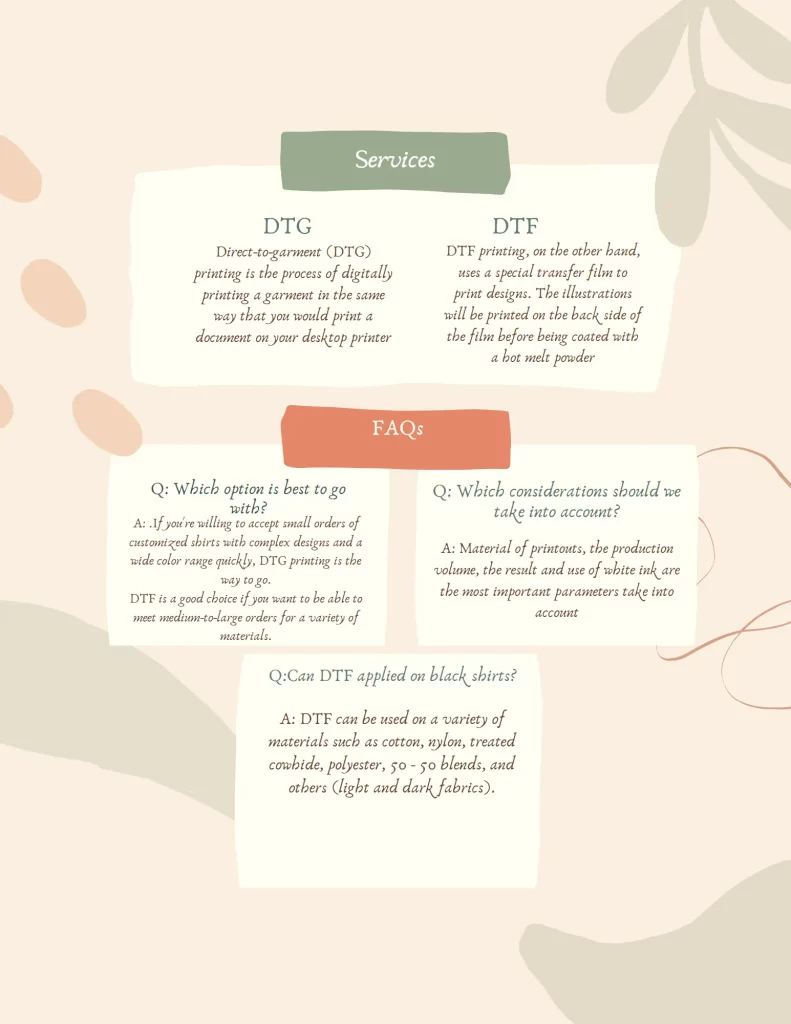

I am Zamal Fatima, a skilled and experienced writer having a passion for technology, gadgets, printers, crafting, and DIY. As a technology expert, I have a deep understanding of the latest advancements in gadgets and devices and am able to produce insightful and informative articles that provide valuable insights into the world of technology. Always striving to improve my skills and knowledge.



